Every few weeks, shipments of gentle draft horses are packed three or four to a crate and loaded onto planes for the long, stressful journey overseas for slaughter.
Horses shipped for slaughter can go 28 hours without food, water, or rest; they can fall during takeoff or landing; and receiving countries have no obligation to report back to Canada on the conditions of horses once they arrive. Organizations and advocates both here in Canada and abroad have shared opposition to live horse export, import, and slaughter. To tell us more about the live horse export industry, the VHS is honoured to welcome a leader in this advocacy work, Sinikka Crosland.

Featured Guest: Sinikka Crosland
Executive Director of the Canadian Horse Defence Coalition
Sinikka is the Executive Director of The Canadian Horse Defence Coalition, a registered non-profit society dedicated to the protection of horses since 2004.
Note: Horse meat is eaten in Canada and various countries in Europe, Asia, and South America. While today’s discussion mentions Japan as the main importer of live horses from Canada, we want to focus on Canada’s role in this issue and share how we can end our contribution to the pain and suffering of animals. This written discussion has been edited for length.
Becoming an advocate for horses

Chantelle: This month we’ll be discussing the live horse export industry and the work being done to stop it. Organizations and advocates both here in Canada and abroad have shared opposition to live horse exports, imports, and slaughter.
To tell us more about this industry and share about the welfare concerns for these horses, we’re honored to welcome leader on the Canadian side of this advocacy work, Sinikka Crosland. Sinikka is the Executive Director of the Canadian Horse Defense Coalition, a registered nonprofit society dedicated to the protection of horses since 2004.
Sinikka, thank you so much for being here today.
Sinikka: Thank you for having me.
Amy: Can you share about your history advocating for horses?
Sinikka: Sure; it can go back a long way, back to childhood. I loved horses and all animals.
I remember being in grade four, and I loved to write. I would write horse stories every day and hand them in to my teacher.
And then finally she said to me, “Can you please not write any horse stories for the whole month of April? Write other things. I love your writing.”
And so it was hard to do, but that’s exactly what I did. I then devoted my month of April to writing about dogs and cats and foxes and cows and pigs and everything else.
So then back to May 1st, I started writing about horses again. I was one of those little kids who just had a fascination for horses. I love all animals. Horses are not my favorite animal by any means because I love them all.
So then from childhood, on it went. When I had started a family already, I got into horse rescue. And this was through a neighborhood group when we lived in West Bank, B.C. We got involved in rescuing horses there and being involved in some other rescues at the time.
And then the PMU (pregnant mare urine) industry came along, where pregnant mares are hooked up to urine collecting devices, collecting estrogen for postmenopausal women.
The foals are the byproduct of that industry. So we discovered that there are a lot of foals out there on the market. We started to go to auctions bid against the meat buyers, and we’d find homes for the foals.
That industry kind of tanked after a while. It’s still out there, but it’s not as prevalent. But there are lots and lots of horses out there needing homes; and I just carried on working on that level.
And so eventually, Canadian Horse Defense Coalition was formed in about 2004. We became a registered nonprofit and things grew to a national level, with even celebrity involvement in recent years.
Amy: That’s amazing.
Chantelle: Yeah. That’s really amazing and we’re really grateful for you to be sharing your expertise today, and I’m sure our audience is as well.
What is the live horse export industry?
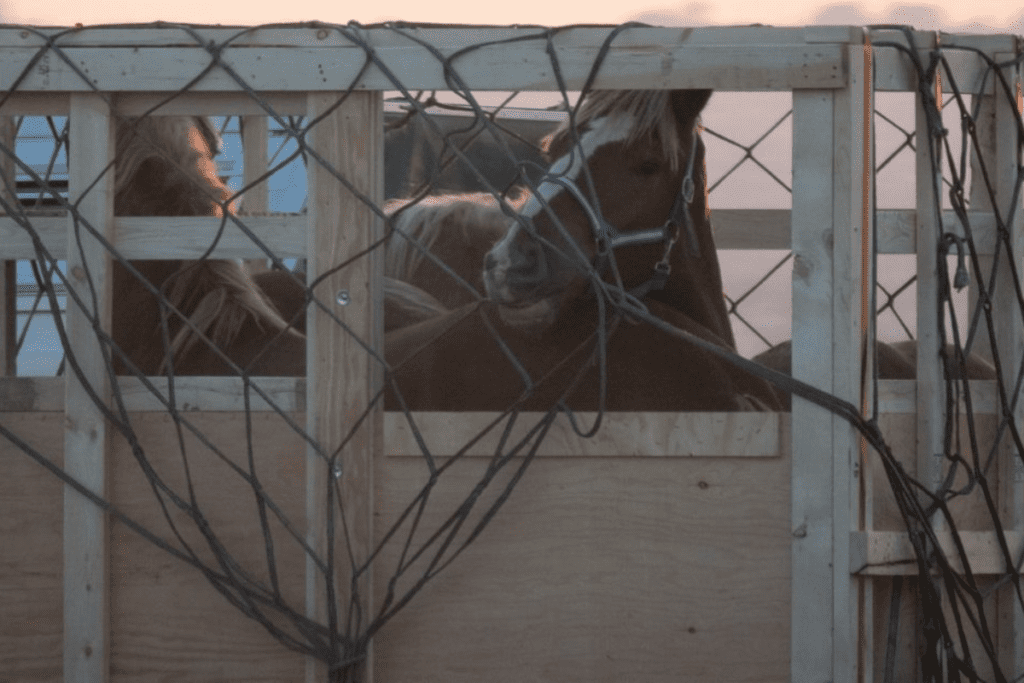
Chantelle: When we talk about the live horse export industry, this is a part of the animal use industry that sort of dwells in the shadows. I think a lot of Canadians aren’t aware that this goes on. Could you give a little bit of background for folks who don’t know what the live horse export industry is and how it works?
Sinikka: The live horse export industry is the process of shipping young draft horses, about between one and a half to three years old, to Japan for slaughter for human consumption.
If people don’t know what draft horses are, the Belgians and Percherons are 16 to 17 hands high, which is somewhere around 64 to 68 inches at the shoulder, and they weigh up to 2000 pounds. So these are big horses.
Canada sends these horses for a delicacy called basashi, which is like a horse sushi, sliced thinly, often served with garlic and soy sauce and served in high-end restaurants. These are very expensive dishes for people to buy.
Chantelle: Thanks so much for that background.
Where do horses shipped for slaughter come from?
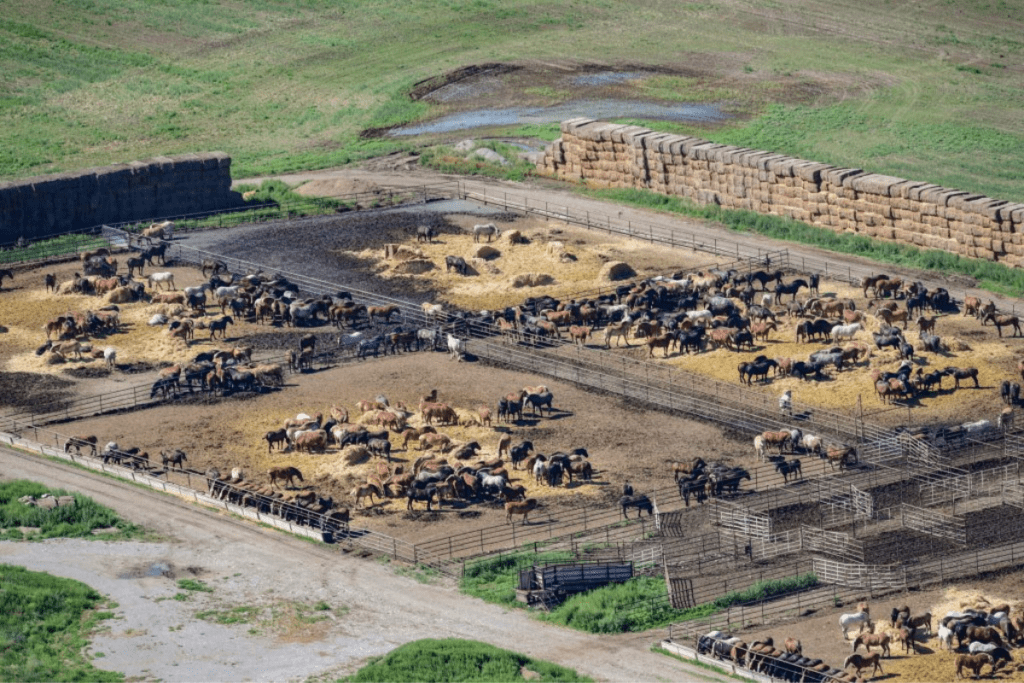
Chantelle: A lot of people think of horses as companion animals, so hearing that horses are being raised and shipped for food can be confusing when folks first hear about it.
Could you help clear up some of that confusion and talk about how horses come to be in this industry?
Sinikka: The horses are basically purpose bred for this industry. There are only a handful of breeders/feedlot operators who do this business in Canada.
The Canadian Food Inspection Agency website says that the horses must originate in Canada. But through access to information, we found out that has changed. So horses from the United States can now cross the border if they have been raised for this purpose and come across to Canada to be shipped from here.
It’s something certainly that our American allies would be interested in hearing about too, that their horses are also coming up to Canada to then be shipped for slaughter.
Amy: I’m curious, does the US have laws about the horses being shipped or is it just a convenience thing that they’re coming into Canada to be shipped?
Sinikka: Right now in the United States, there is no domestic horse slaughter going on. But the feedlot operators down there are quite happy to ship them across the border to Canada and even to Mexico for slaughter elsewhere.
Horses suffer when shipped on long journeys to slaughter
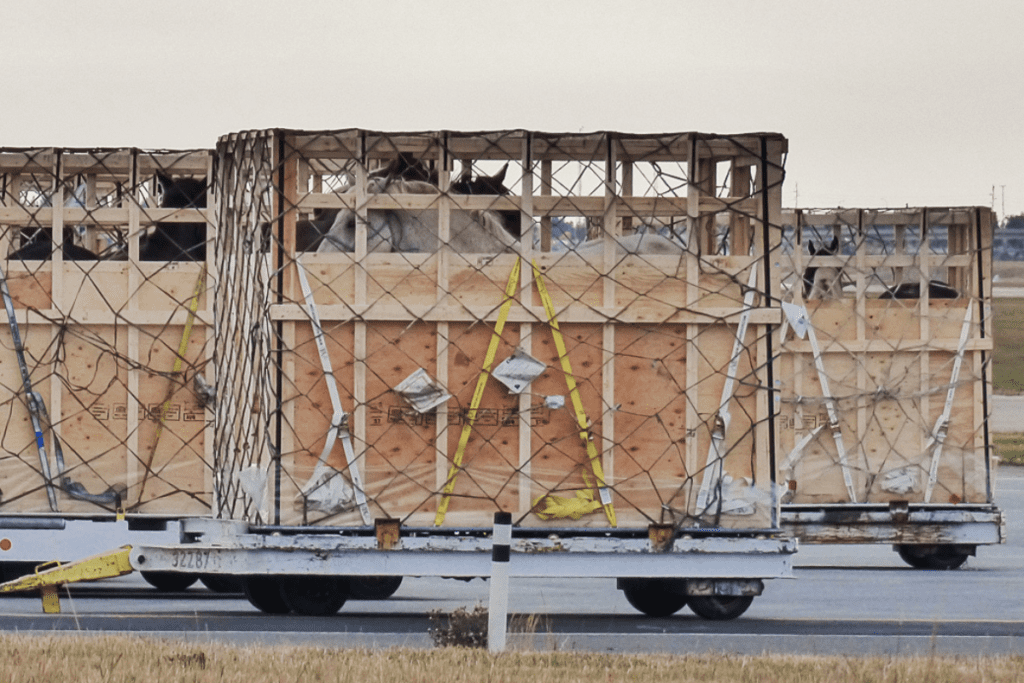
Amy: What are some of the welfare concerns for these horses who are being shipped for slaughter?
Sinikka: The welfare concerns are many.
It starts with the feed lot, the way that they’re born onto the feed lot.
If something goes wrong and a horse needs veterinary care, farrier care with bad hooves and that type of thing, basically in a feedlot, it’s nonexistent. These problems that can happen are often ignored.
There’s no weather protection in many feed lots, so foals that are born in the winter or early spring can freeze to death.
So you have the feedlot problems and you’ve got the transport problems. Now we’re looking at long distance transport from the United States. That’s another problem where horses are crammed into trucks and shipped from the United States.
And then once they get here, they come to a quarantine feedlot in Canada where horses are kept in pre-export isolation for 45 days. The horses from the United States have to be kept an additional six months. The feedlot situation, as I’ve mentioned, is horrible, and that’s extra time that they must be kept in that situation.
So then at the end of that time that they’re the pre-export isolation, they’re taken to be transported to one of three airports in Canada: Calgary, Edmonton, and Winnipeg is where they’re flown out.
There they are put into small wooden crates. They can often stand for a long time on the tarmac waiting for the crates to be ready to be put onto the plane. Three to four large draft horses are crammed into a single crate.
There’s often a problem with headroom because these are tall horses. Their heads can come in contact with the netting at the top. And this is totally a violation of the Health of Animals regulations that their heads come into contact with, with the netting at the top.
So then they have this journey, which can take anywhere from 10 to 13, 14 hours. They can’t lie down, but they do sometimes fall down. And then you have a downed horse in a crate with other horses.
There’s no way of anyone being able to help a horse in distress. You can imagine if you have 30 crates in an aircraft, usually what they send is between 90 and 120 horses per shipment. So there you have them all crammed in there, and how can they be helped?
There have been horses that have been dead on arrival or wounded, injured, that type of thing.
They reach Japan, they’re unloaded at that end, and they still have the journey to the feedlot at that point. Right now in Canada, the regulation is 28 hours they’re allowed to go without food, water, and rest. And that’s from the beginning when they leave the feedlot here to the time that they arrive.
28 hours is a long time, but if there are any delays—which we have seen through access of information that there have been delays—then that period of time can go beyond 30 or more hours.
The other issue is once they arrive, we have no jurisdiction over there anymore. They’re at the mercy of the laws and policies at the other end
Amy: It sounds like there’s a number of aspects of their welfare that get compromised throughout that whole process.
Next steps to end the live horse export industry
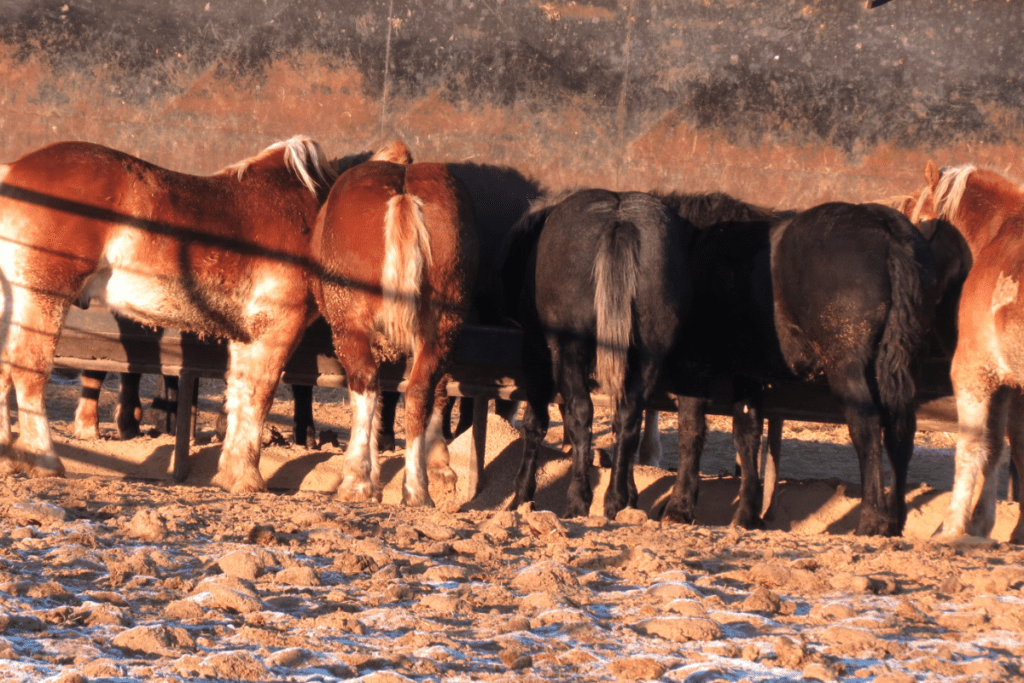
Amy: The federal government committed to ending this industry and their campaign platform and the Prime Minister’s mandate letter to the Minister of Agriculture that was sent in December 2021. So what would you like to see as the next steps to end this industry?
Sinikka: I would really like to see the Prime Minister put pressure on the agriculture Minister to do as he ordered. It’s not a case of, “Here, have a look at this and see what you think about it.” It’s, “I want you to end this,” and yet there has been nothing but delay after delay. The excuses just go on and on. It appears to me that this is a low priority for them.
I would like to see more pressure put on the government. This can come a variety of ways, through more public awareness, more media involvement.
Now that we know there’s a connection to the United States horses coming from there, it would be very handy to have American media cover this and put pressure on the Canadian government.
How you can help horses
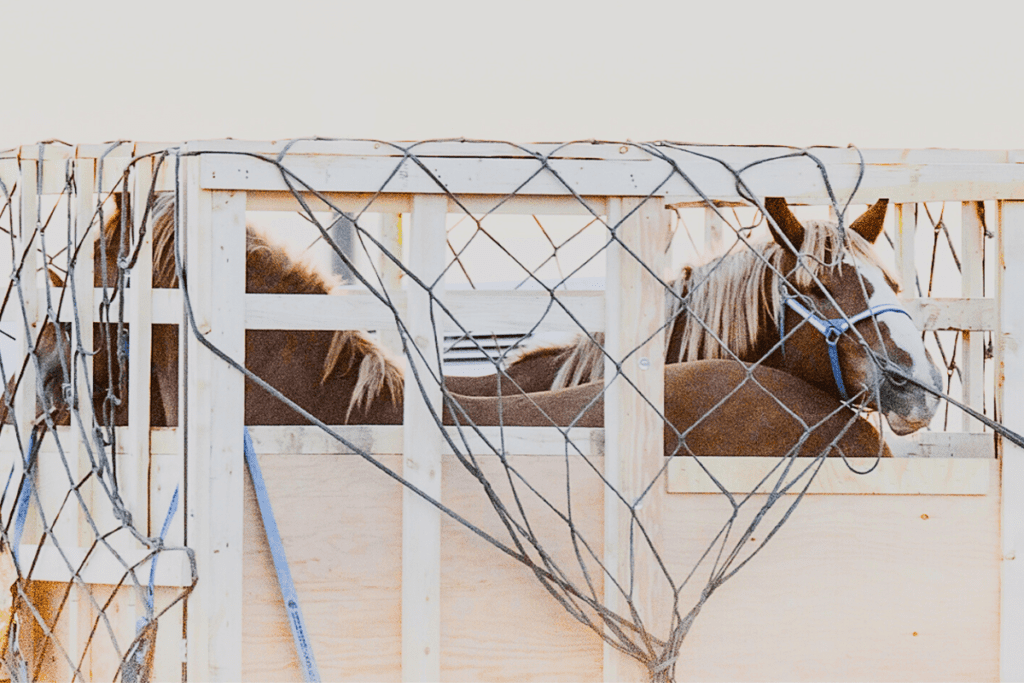
Chantelle: Something we always ask is what steps the folks listening at home can take to help.
Right now, we know there’s a really important window of opportunity to take action on this issue. Could you share with listeners how folks at home can advocate for an end to the live horse export industry?
Sinikka: There are quite a few things that people can do. Right now there’s an active petition, Petition E-4190, sponsored by MP Alistair MacGregor and initiated by singer, songwriter, animal lover, Jann Arden.
If people go to horseshit.ca, it’s her website and she’s working hard to raise awareness. There are steps that people can take there: they can write to their MP; they can sign that petition.
People can talk to their MPs too, they can make appointments to go in and visit with their MPs, or write them letters, or phone them up. Tell them that this was a promise that this industry should be stopped.
They can write letters to editors of their local papers. This is a way of letting people in the community know who may not even have heard of this industry, and who will hear about it and be quite appalled by it. That would be a way of encouraging other people to go to Jann’s website and find out how to sign the petition.
And with all this pressure being put on the government, we can see that that would really help.
Chantelle: Yeah, absolutely. This is a really important opportunity to make a change right now for animals who are suffering and to advocate directly to your decision makers. So thank you so much for sharing that information Sinikka.
And as we’ve mentioned before, a shift toward plant-based foods is needed worldwide to decrease the demand for industrial animal agriculture. So you can make a difference standing up for animals every time you sit down to choose a meal.
Take action
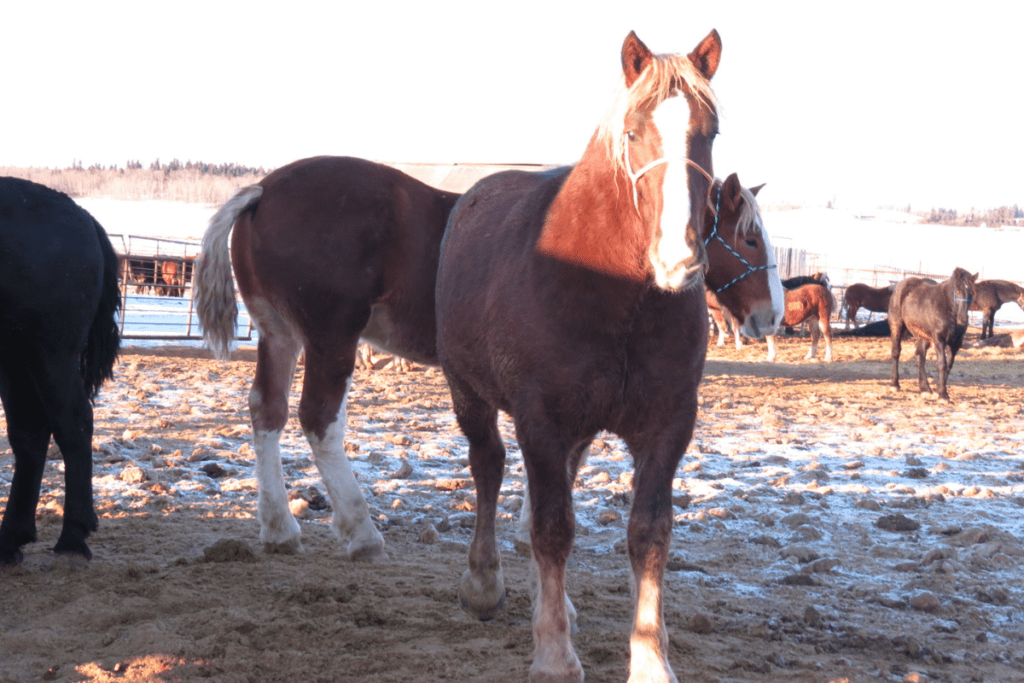
Chantelle: As always, we know this is a really heavy topic for folks listening, but it’s so valuable for people to learn and share about it so that we can all work together and make a difference for these animals. Thank you so much for being here with us today, Sinikka.
Sinikka: You’re very welcome. I appreciate being here and spreading the word.
Chantelle: We really appreciate having you, and for those of you listening, we hope you’ll join us next month as we wrap up our series on animal cruelty with a discussion on how all these laws we’ve been talking about are enforced. We’ll see you next time.
